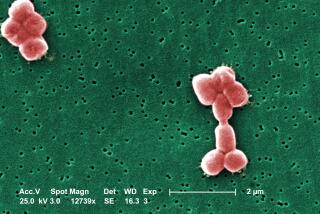Blunting the tsetse fly’s deadly bite
Always hungry for blood, the tsetse fly packs a painful bite. Worse yet, its attack can leave a hapless victim infected with a parasitic disease that kills thousands of people — and millions of livestock — each year.
While Human African trypanosomiasis, or “sleeping sickness,” has been declared a neglected tropical disease endemic to Sub Saharan Africa, new research is raising hopes that something might be done to slow its spread by targeting its sole carrier — the tsetse.
In a paper published Thursday in the journal Science, researchers said they had sequenced the genome of one species, Glossina morsitans, and identified several potential weaknesses that might be exploited in the fight against sleeping sickness, or nagana, as its known in animals.
“Tsetse flies carry a potentially deadly disease and impose an enormous economic burden on countries that can least afford it by forcing farmers to rear less productive but more trypanosome-resistant cattle,” said co-author Matthew Berriman, a pathogen geneticist at the Wellcome Trust Sanger Institute, in England.
“Our study will accelerate research aimed at exploiting the unusual biology of the tsetse fly,” Berriman said in a prepared statement.
The tsetse fly is unique for many reasons: It lives much longer than most other flies, it gives birth to fully developed larvae instead of laying eggs, and it survives only on blood. (Even mosquitoes will supplement their diets with plant nectar.)
Female Glossina also produce milk proteins that are used to nourish the developing larvae during pregnancy.
But what causes the tsetse’s bite to become deadly are trypanosomes, protozoan parasites shaped like eels. Not all tsetse flies are infected with the parasites, but those that are can spread them to humans and animals while feeding on blood.
Once inside a human, the parasites will begin reproducing. Initially, the victim will experience, headaches, fever or rashes, but ultimately the parasite will damage the central nervous system, causing sleep disturbances, changes in behavior, confusion, and poor coordination. Without treatment, health experts say the disease will become fatal.
The team that studied the tsetse fly’s genome included 146 scientists from 18 countries.
By mapping the fly’s genome, researchers found that the insects produce several salivary molecules that are essential for sucking up and digesting blood (They will consume roughly their entire weight’s worth of fluid during a feeding.)
The salivary molecules helped to reduce blood coagulation and vessel constriction, as well as inflammation and irritation. Interestingly, when a fly is infected with the parasites, production of these compounds is reduced, requiring longer feeding times and increasing the likelihood that parasites will be spread to a new host.
After a tsetse fly has consumed its blood meal, a number of proteins help to rapidly remove excess water, which is excreted from the insect’s abdomen in a large droplet. If the production of these proteins are reduced, the flies will suffer reduced heat tolerance and longer pregnancies.
Researchers also studied the insect’s microbiome, and found that it harbors a bacterium — Wigglesworthia glossinidia — that helps provide pregnant flies with B vitamins and other nutrients. If the bacterium is absent, the pregnant flies will prematurely abort their offspring, researchers wrote.
It remains unclear exactly how these and other discoveries can be used to reduce the spread of sleeping sickness, but authors noted that their research confirmed the use of an existing fly-catching tactic.
When study authors examined the genes that controlled its target seeking behavior, they noted that it possessed a photoreceptor gene that caused it to be attracted to black and blue colors.
Study authors noted that health officials were already using blue and black fly traps to catch the insects.







